Lightweight Composite Partitions with High Sound Insulation in Hotel Interior Spaces: Design and Application
Abstract
:1. Introduction
2. Theory Analysis
2.1. Simulation of Single Layer Partition
2.2. Sound Insulation Theory of Multilayer Composite Partition
3. Simulation and Experiment Setup
3.1. Configuration Design for Composite Partition
3.2. Simulation Models
3.3. Experimental Settings
4. Results and Discussion
4.1. Insulation Performance of the Base Case
4.2. Elastic Panel Parameters Discussed
4.2.1. Influence of Young’s Modulus
4.2.2. Influence of Gypsum Board’s Thickness
4.2.3. Influence of Density
4.3. Influence of the VEM Core’s Thickness
4.4. Influence of Composite Partition Walls’ Configuration
4.5. Optimal Configuration
5. Conclusions
- (1)
- The parameters of Young’s modulus, thickness, surface density and VEM damping core layer thickness of elastic panel are important factors influencing the sound insulation performance of CLD partitions.
- (2)
- As for lightweight and high sound insulation composite partition, the sound insulation performance can be improved by using different inter-layer combinations.
- (3)
- Adding VEM layer to the configuration can effectively suppress and reduce the resonance valley in the first stiffness control area, which thus can effectively improve the sound insulation performance of the whole structure.
Author Contributions
Funding
Institutional Review Board Statement
Informed Consent Statement
Data Availability Statement
Acknowledgments
Conflicts of Interest
References
- Alves, J.A.; Silva, L.T.; Remoaldo, P.C.C. The Influence of Low-Frequency Noise Pollution on the Quality of Life and Place in Sustainable Cities: A Case Study from Northern Portugal. Sustainability 2015, 7, 13920–13946. [Google Scholar] [CrossRef] [Green Version]
- Kong, Z.; Jakubiec, J.A. Evaluations of long-term lighting qualities for computer labs in Singapore. Build. Environ. 2021, 194, 107689. [Google Scholar] [CrossRef]
- Kong, Z.; Utzinger, D.M.; Freihoefer, K.; Steege, T. The impact of interior design on visual discomfort reduction: A field study integrating lighting environments with POE survey. Build. Environ. 2018, 138, 135–148. [Google Scholar] [CrossRef]
- Kong, Z.; Zhang, R.; Ni, J.; Ning, P.; Kong, X.; Wang, J. Towards an integration of visual comfort and lighting impression: A field study within higher educational buildings. Build. Environ. 2022, 216, 108989. [Google Scholar] [CrossRef]
- Lin, J.; Tan, H.; Xu, C.; Shi, H.R. Research Progress of Acoustic Technology in Buildings. Build. Sci. 2013, 29, 10. [Google Scholar]
- Mansilla, J.; Masson, F.; Palma, I.D.; Pepino, L.; Bender, L. Sound Insulation of Homogeneous Single Panels: A Comparison Between Real Construction Materials and Several Prediction Models. In Proceedings of the 24th International Congress on Sound and Vibration, London, UK, 23–27 July 2017; pp. 1–8. [Google Scholar]
- Bader Eddin, M.; Ménard, S.; Bard Hagberg, D.; Kouyoumji, J.L.; Vardaxis, N.G. Prediction of Sound Insulation Using Artificial Neural Networks—Part I: Lightweight Wooden Floor Structures. Acoustics 2022, 4, 13. [Google Scholar] [CrossRef]
- Bader Eddin, M.; Vardaxis, N.G.; Ménard, S.; Bard Hagberg, D.; Kouyoumji, J.L. Prediction of Sound Insulation Using Artificial Neural Networks—Part II: Lightweight Wooden Façade Structures. Appl. Sci. 2022, 12, 6983. [Google Scholar] [CrossRef]
- Vardaxis, N.G.; Hagberg, D.B. Review of acoustic comfort evaluation in dwellings: Part III—airborne sound data associated with subjective responses in laboratory tests. Build. Acoust. 2018, 25, 289–305. [Google Scholar] [CrossRef]
- Vardaxis, N.G.; Hagberg, D.B.; Dahlström, J. Evaluating Laboratory Measurements for Sound Insulation of Cross-Laminated Timber (CLT) Floors: Configurations in Lightweight Buildings. Appl. Sci. 2022, 12, 7642. [Google Scholar] [CrossRef]
- Larbi, W.; Deü, J.F.; Ohayon, R. Vibroacoustic analysis of double-wall sandwich panels with viscoelastic core. Comput. Struct. 2016, 174, 92–103. [Google Scholar] [CrossRef]
- Hwang, S.; Kim, J.; Lee, S.; Kwun, H. Prediction of sound reduction index of double sandwich panel. Appl. Acoust. 2015, 93, 44–50. [Google Scholar] [CrossRef]
- Jung, W.; Gu, Z.; Baz, A. Mechanical filtering characteristics of passive periodic engine mount. Finite Elem. Anal. Des. 2010, 46, 685–697. [Google Scholar] [CrossRef]
- Pellicier, A.; Trompette, N. A review of analytical methods, based on the wave approach, to compute partitions transmission loss. Appl. Acoust. 2007, 68, 1192–1212. [Google Scholar] [CrossRef]
- Guptat, B.V.R.; Ganesan, N.; Narayanan, S. Finite element free vibration analysis of damped stiffened panels. Comput. Struct. 1986, 24, 485–489. [Google Scholar] [CrossRef]
- Zhou, X.Q.; Yu, D.Y.; Shao, X.; Wang, S.; Zhang, S.Q. Simplified-super-element-method for analyzing free flexural vibration characteristics of periodically stiffened-thin-plate filled with viscoelastic damping material. Thin-Walled Struct. 2015, 94, 234–252. [Google Scholar] [CrossRef]
- Moore, J.A.; Lyon, R.H. Sound transmission loss characteristics of sandwich panel constructions. J. Acoust. Soc. Am. 1991, 89, 777–791. [Google Scholar] [CrossRef]
- Aloufi, B.; Behdinan, K.; Zu, J. Vibro-acoustic model of an active aircraft cabin window. J. Sound Vib. 2017, 398, 1–27. [Google Scholar] [CrossRef]
- Tadeu, A.J.B.; Mateus, D.M.R. Sound transmission through single, double and triple glazing. Exp. Evaluat. Appl. Acoust. 2001, 62, 307–325. [Google Scholar] [CrossRef] [Green Version]
- Thamburaj, P.; Sun, J.Q. Effect of Material and Geometry on the Sound and Vibration Transmission across a Sandwich Beam. J. Vib. Acoust. 2001, 123, 205–212. [Google Scholar] [CrossRef]
- Yang, Y.; Fenemore, C.; Kingan, M.J.; Mace, B.R. Analysis of the vibroacoustic characteristics of cross laminated timber panels using a wave and finite element method. J. Sound Vib. 2021, 494, 115842. [Google Scholar] [CrossRef]
- Varanasi, S.; Bolton, J.S.; Siegmund, T.H.; Cipra, R.J. The low frequency performance of metamaterial barriers based on cellular structures. Appl. Acoust. 2013, 74, 485–495. [Google Scholar] [CrossRef]
- Li, J.; Li, S. Sound Transmission Through Metamaterial-Based Double-Panel Structures With Poroelastic Cores. Acta Acust. United Acust. 2017, 103, 869–884. [Google Scholar] [CrossRef]
- Kim, Y.; ASME, M. Identification of Acoustic Characteristics of Honeycomb Sandwich Composite Panels Using Hybrid Analytical/Finite Element Method1. J. Vib. Acoust. 2013, 135, 011006-1–011006-11. [Google Scholar] [CrossRef]
- Guerich, M. Optimization of Noise Transmission Through Sandwich Structures. J. Vib. Acoust. 2013, 135, 051010-1–051010-13. [Google Scholar] [CrossRef]
- Zhou, X.Q.; Zhang, S.Q.; Lin, W.W. Sound radiation characteristics analysis for the honeycomb reinforced laminated structures with viscoelastic material fillers through the asymptotic homogenous method. Compos. Struct. 2020, 245, 112266. [Google Scholar] [CrossRef]
- Li, Q.; Iu, V.P.; Kou, K.P. Three-dimensional vibration analysis of functionally graded material sandwich plates. J. Sound Vib. 2008, 311, 498–515. [Google Scholar] [CrossRef]
- Huang, C.; Nutt, S. Sound transmission prediction by 3-D elasticity theory. Appl. Acoust. 2009, 70, 730–736. [Google Scholar] [CrossRef]
- Chandra, N.; Raja, S.; Nagendra Gopal, K.V. Vibro-acoustic response and sound transmission loss analysis of functionally graded plates. J. Sound Vib. 2014, 333, 5786–5802. [Google Scholar] [CrossRef]
- Kurtze, G.; Watters, B.G. New Wall Design for High Transmission Loss or High Damping. J. Acoust. Soc. Am. 1959, 31, 739–748. [Google Scholar] [CrossRef]
- Li, J.; Li, S. Sound transmission through a damped sandwich panel. Acta Acust. United Acust. 2017, 80, 315–327. [Google Scholar]
- Wang, J.; Lu, T.J.; Woodhouse, J.; Langley, R.S.; Evans, J. Sound transmission through lightweight double-leaf partitions: Theoretical modelling. J. Sound Vib. 2005, 286, 817–847. [Google Scholar] [CrossRef]
- Nilsson, A.C. Wave propagation in and sound transmission through sandwich plates. J. Sound Vib. 1990, 138, 73–94. [Google Scholar] [CrossRef]
- Niu, B.; Olhoff, N.; Lund, E.; Cheng, G. Discrete material optimization of vibrating laminated composite plates for minimum sound radiation. Int. J. Solids Struct. 2010, 47, 2097–2114. [Google Scholar] [CrossRef] [Green Version]
- Bouzouane, B.; Ghorbel, A.; Akrout, A.; Abdennadher, M.; Boukharouba, T.; Haddar, M. Ultra-thin films effects on vibro-acoustic behaviour of laminated plate including a viscoelastic core. Appl. Acoust. 2019, 147, 121–132. [Google Scholar] [CrossRef]
- Chandra, N.; Gopal, K.V.N.; Raja, S. Vibro-acoustic response of sandwich plates with functionally graded core. Acta Mech. 2017, 228, 2775–2789. [Google Scholar] [CrossRef]
- Nilsson, A.; Baro, S.; Piana, E.A. Vibro-acoustic properties of sandwich structures. Appl. Acoust. 2018, 139, 259–266. [Google Scholar] [CrossRef]
- Assaf, S.; Guerich, M. Numerical Prediction of Noise Transmission Loss through Viscoelastically Damped Sandwich Plates. J. Sandw. Struct. Mater. 2008, 10, 359–384. [Google Scholar] [CrossRef]
- Santoni, A.; Schoenwald, S.; Fausti, P.; Tröbs, H.M. Modelling the radiation efficiency of orthotropic cross-laminated timber plates with simply-supported boundaries. Appl. Acoust. 2019, 143, 112–124. [Google Scholar] [CrossRef]
- Guyader, J.L.; Lesueur, C. Acoustic transmission through orthotropic multilayered plates, part I: Plate vibration modes. J. Sound Vib. 1978, 58, 51–68. [Google Scholar] [CrossRef]
- Guyader, J.L.; Lesueur, C. Acoustic transmission through orthotropic multilayered plates, part II: Transmission loss. J. Sound Vib. 1978, 58, 69–86. [Google Scholar] [CrossRef]
- Huang, C.; Nutt, S. An analytical study of sound transmission through unbounded panels of functionally gradedmaterials. J. Sound Vib. 2011, 330, 1153–1165. [Google Scholar] [CrossRef]
- Kang, L.; Sun, C.; An, F.; Liu, B. A bending stiffness criterion for sandwich panels with high sound insulation and its realization through low specific modulus layers. J. Sound Vib. 2022, 536, 117149. [Google Scholar] [CrossRef]
- Howson, W.P.; Zare, A. Exact dynamic stiffness matrix for flexural vibration of three-layered sandwich beams. J. Sound Vib. 2005, 282, 753–767. [Google Scholar] [CrossRef]
- Backström, D.; Nilsson, A.C. Modelling the vibration of sandwich beams using frequency-dependent parameters. J. Sound Vib. 2007, 300, 589–611. [Google Scholar] [CrossRef]
- Wang, C. Modal sound transmission loss of a single leaf panel: Effects of intermodal coupling. J. Acoust. Soc. Am. 2015, 6, 3514–3522. [Google Scholar] [CrossRef] [PubMed]
- Wang, C. Modal sound transmission loss of a single leaf panel: Asymptotic solutions. J. Acoust. Soc. Am. 2015, 138, 3964–13575. [Google Scholar] [CrossRef] [PubMed]
- GB 50118-2010; Code for Design of Sound Insulation of Civil Buildings. Ministry of Housing and Urban-Rural Development of the People’s Republic of China. China Architecture & Building Press: Beijing, China, 2010.
- Comsol Multiphysics. COMSOL Multiphysics User’s Guide; COMSOL, Inc.: Burlington, VT, USA, 2020. [Google Scholar]
- GB/Z 22764-2011; Acoustics-Determination of Sound Transmission Loss in Impendence Tubes-Transfer Matrix Method. Standardization Administration of China: Beijing, China, 2012.
- ASTM E2611-09; Standard Test Method for Measurement of Normal Incidence Sound Transmission of Acoustical Materials Based on the Transfer Matrix Method. ASTMInternational: West Conshohocken, PA, USA, 2009.
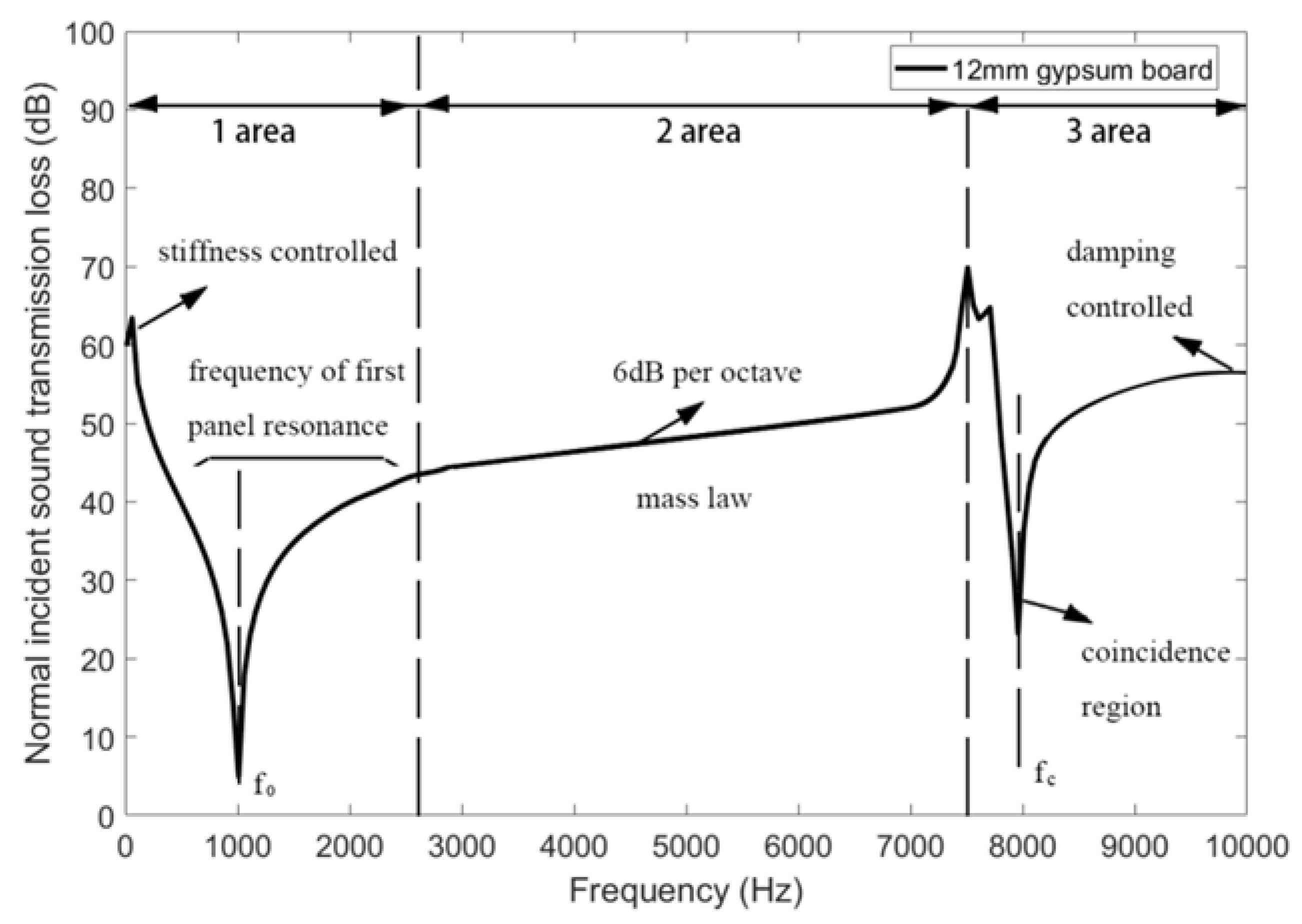
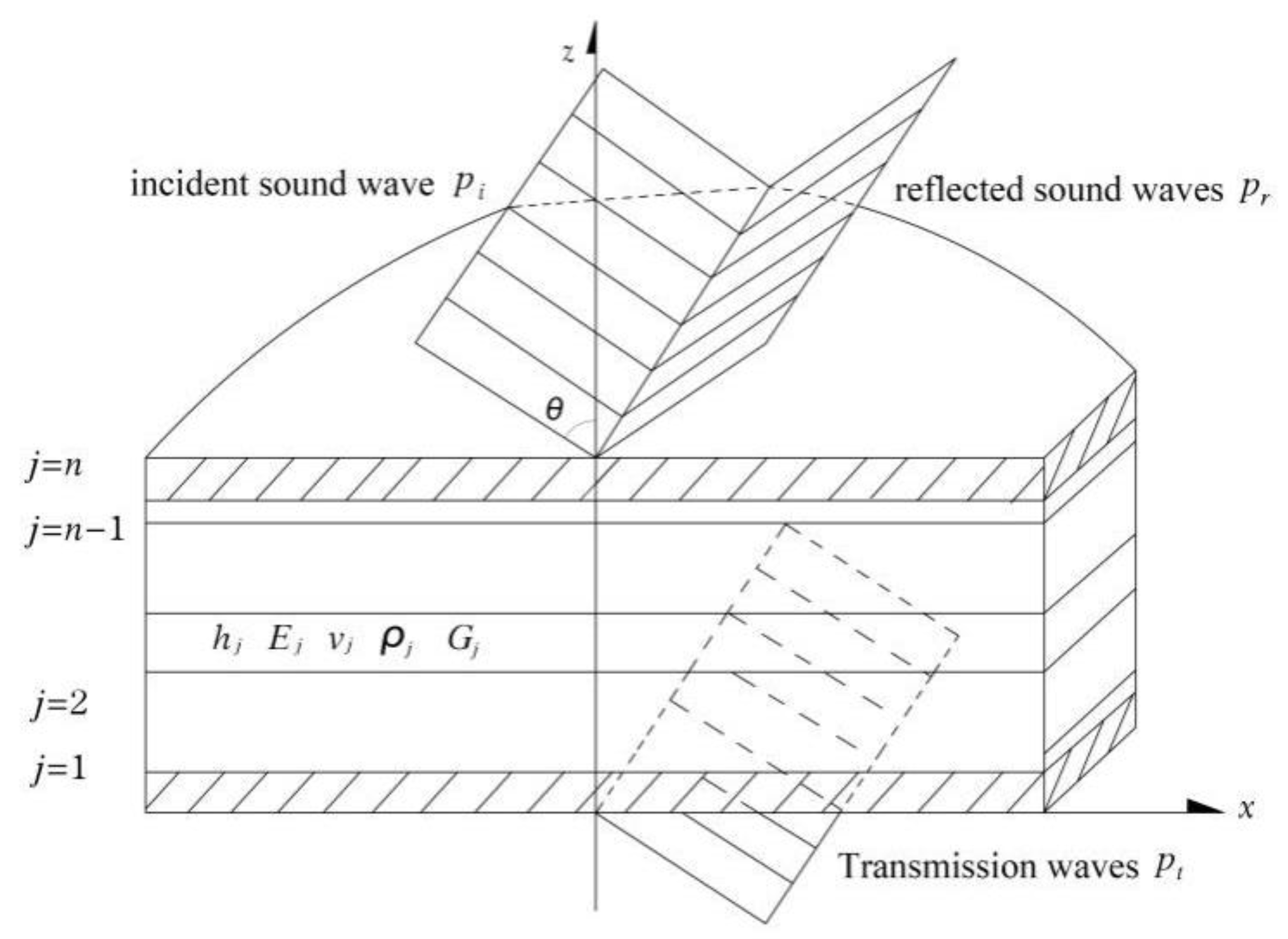

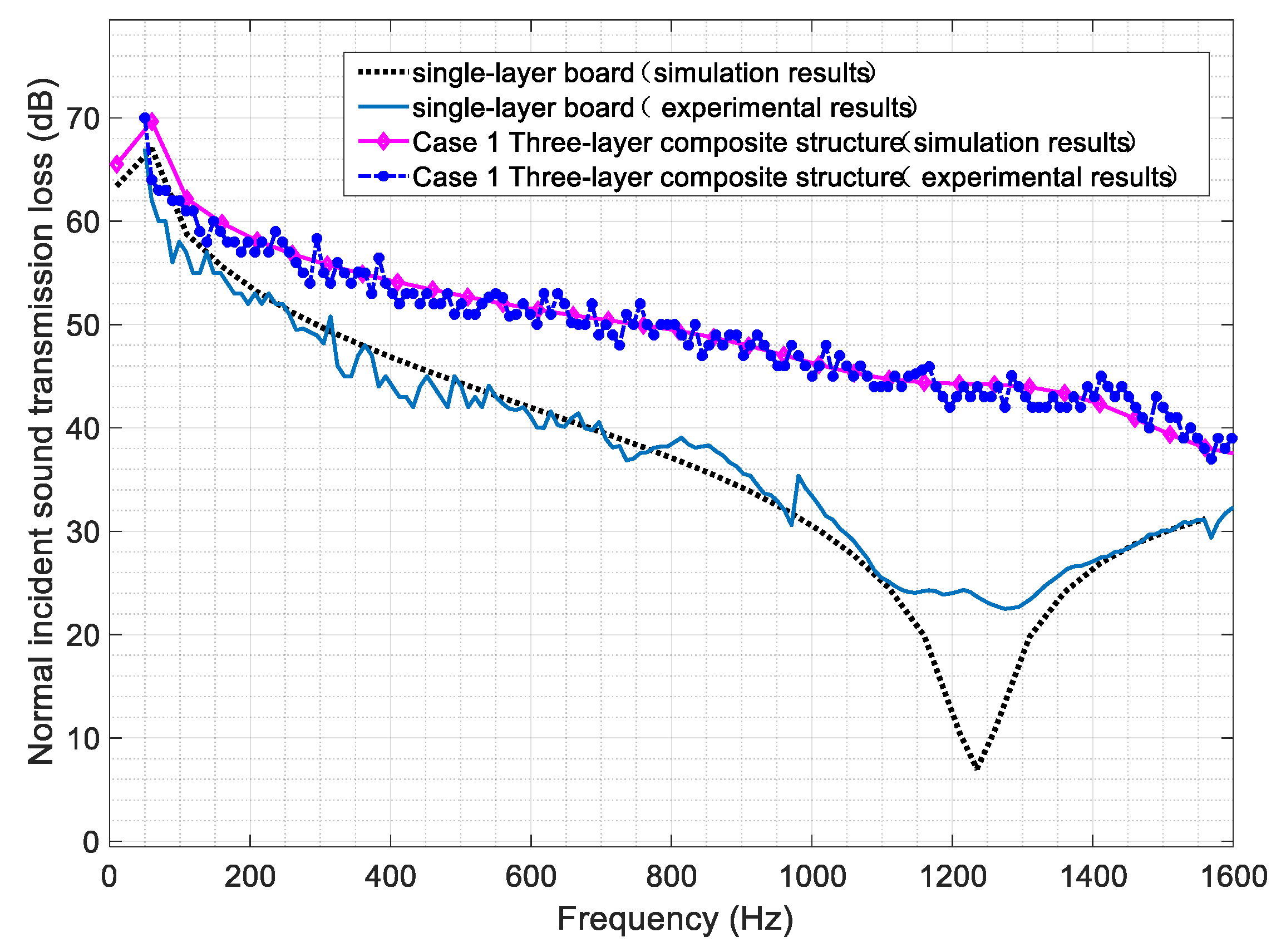
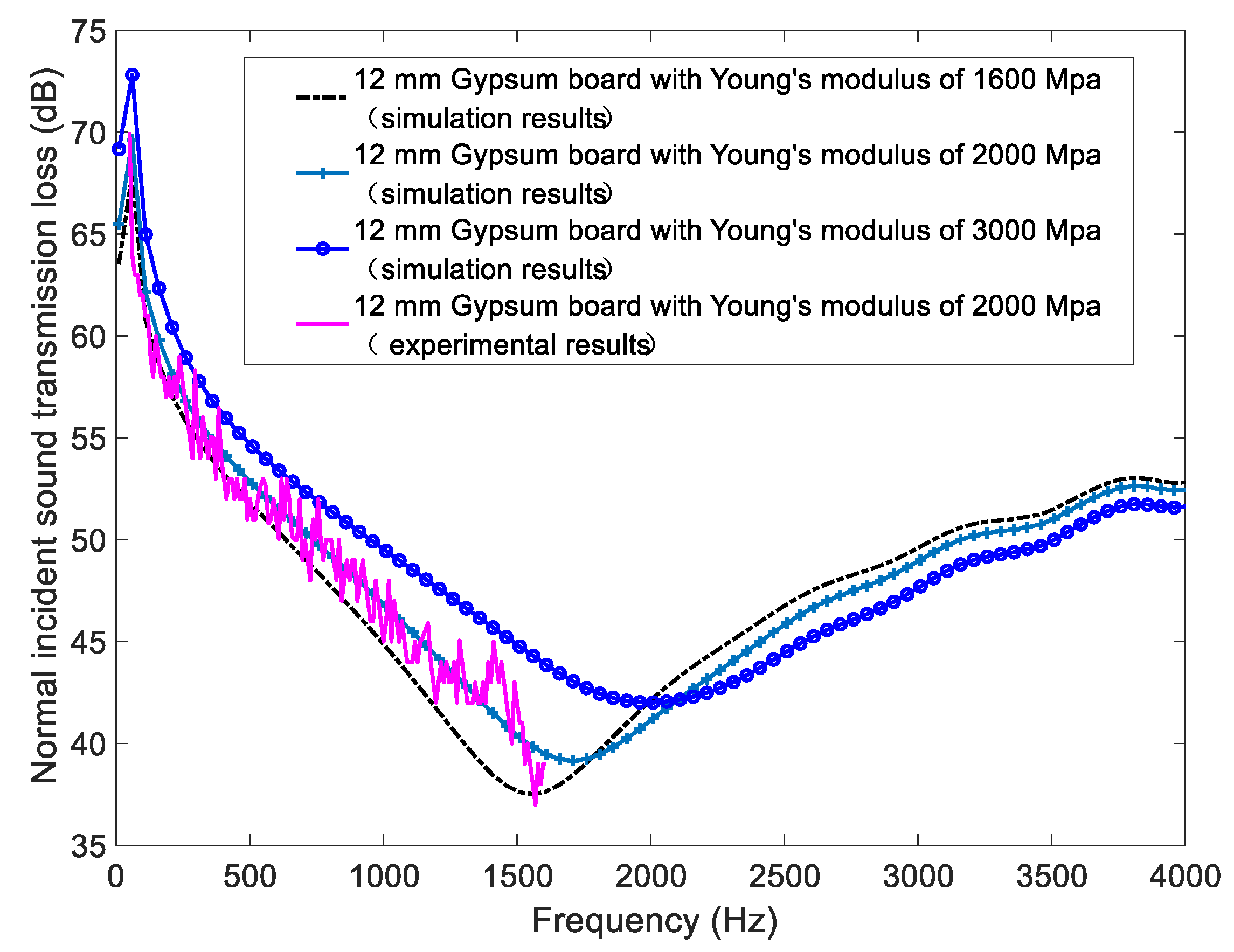
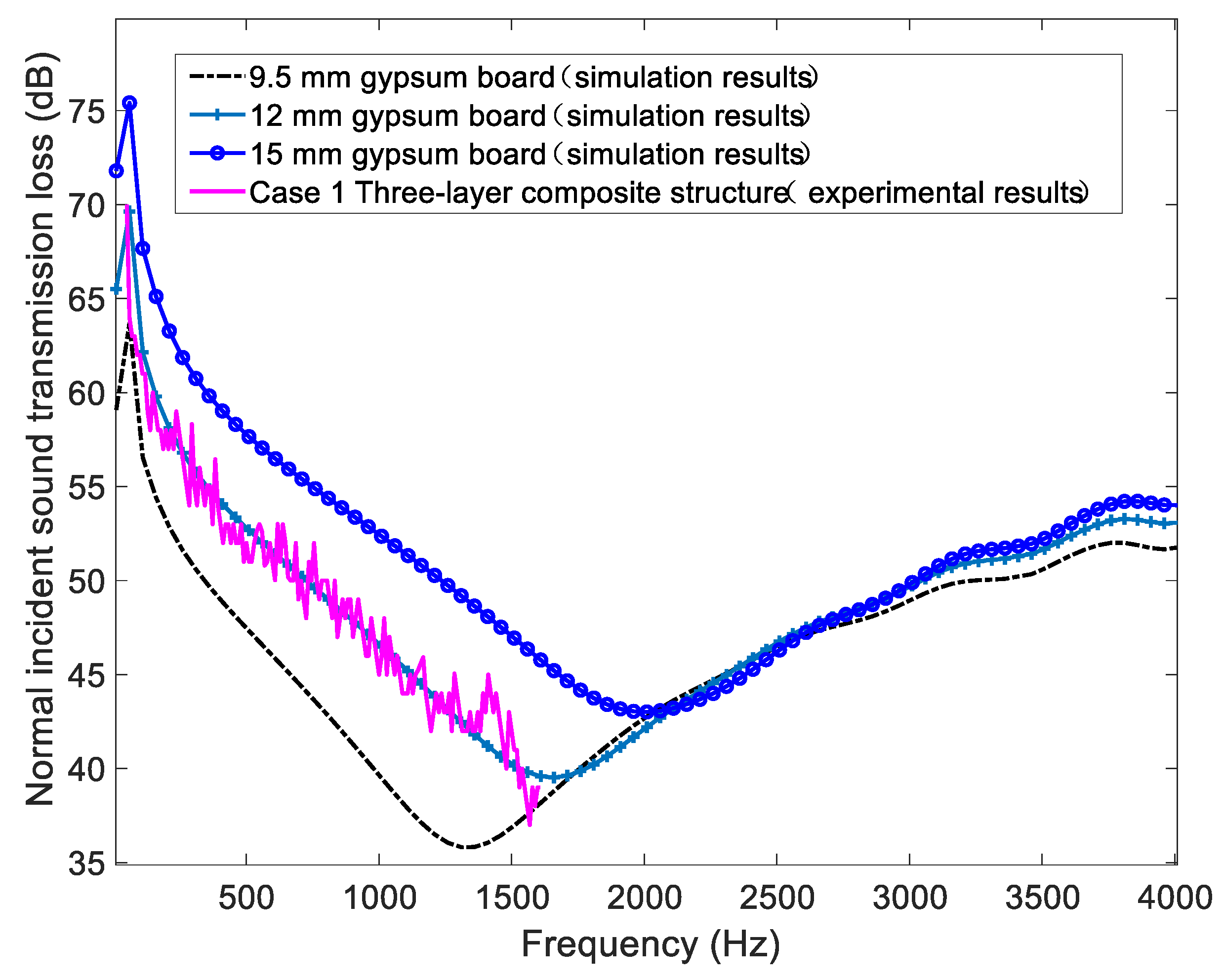

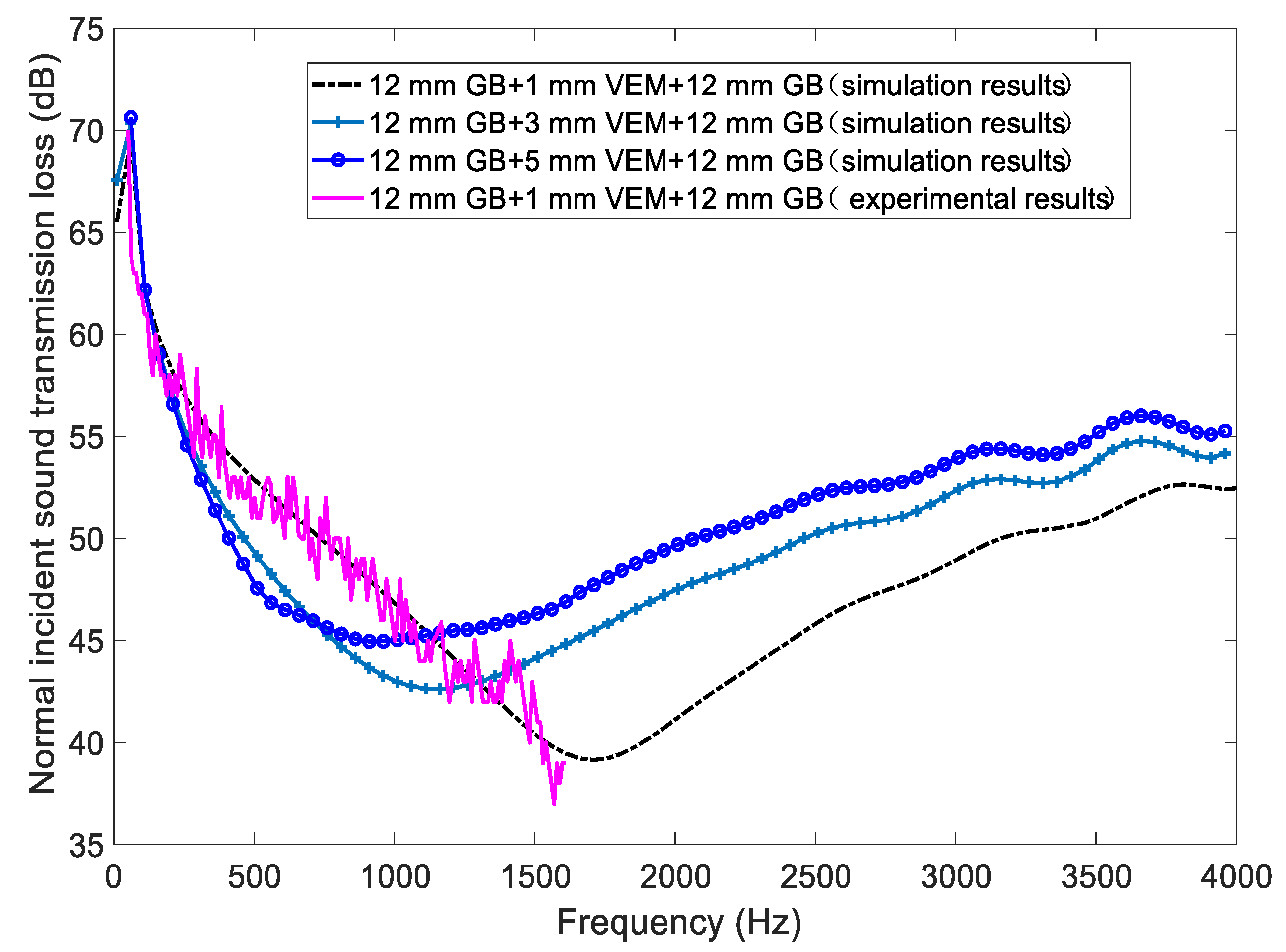
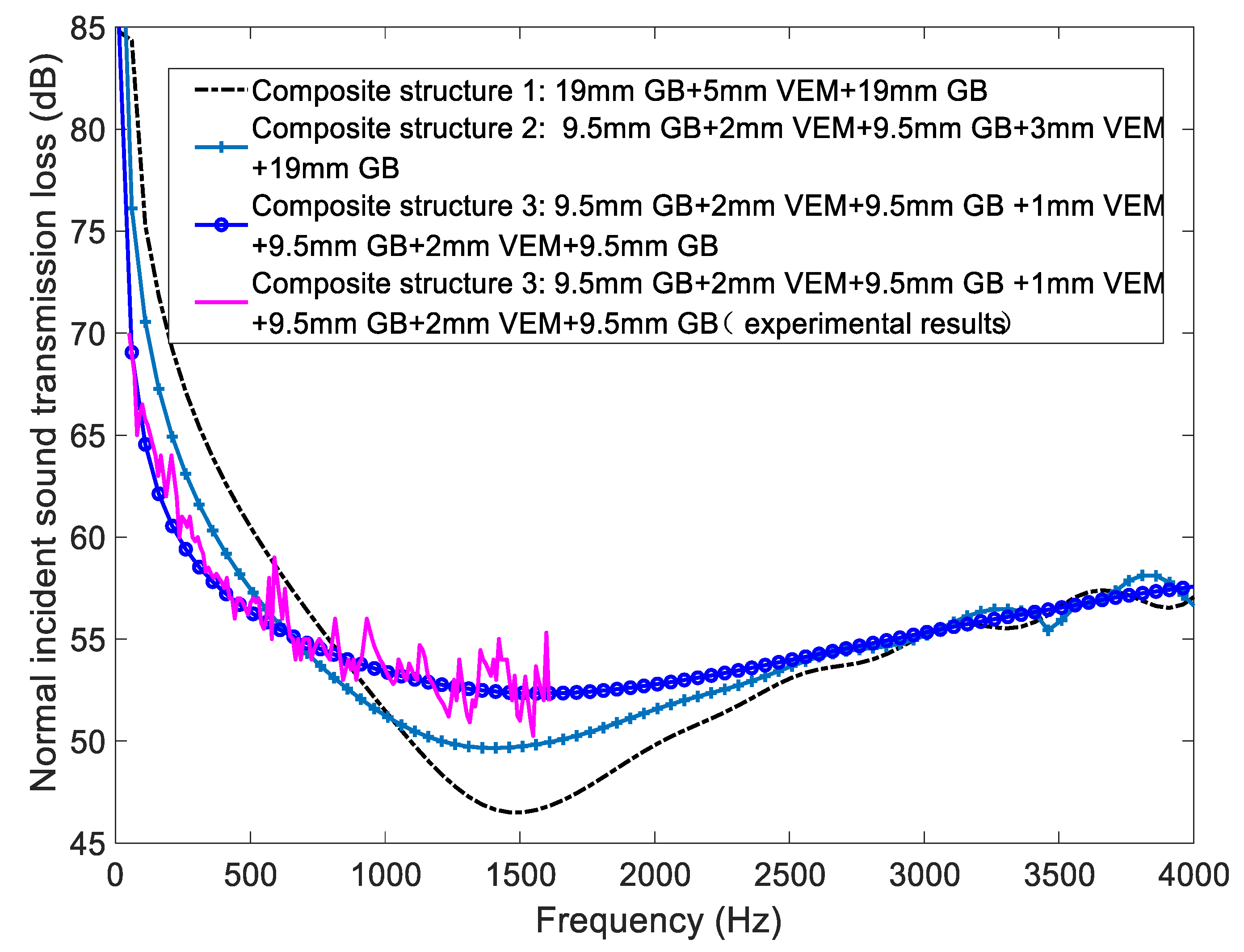
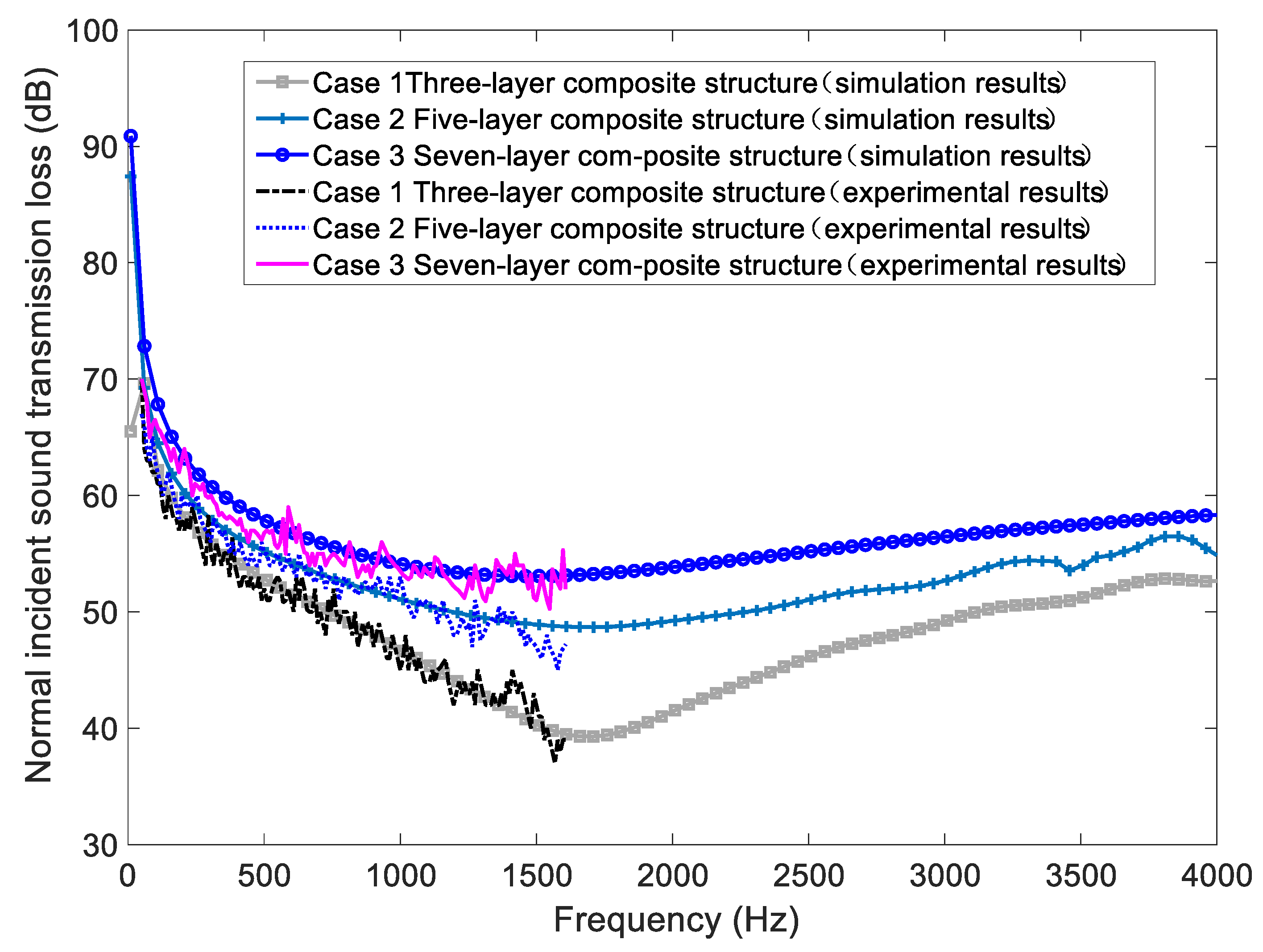
| Name | Type | Material Specification (mm) | Thickness (mm) | Surface Density (kg/m2) |
|---|---|---|---|---|
| Case 1 | Three-layer composite structure | 12 gypsum board + 1 IIR + 12 gypsum board | 25 | 15.4 |
| Case 2 | Five-layer composite structure | 12 gypsum board + 2 IIR + 9.5 gypsum board + 1 IIR + 9.5 gypsum board | 34 | 23.8 |
| Case 3 | Seven-layer composite structure | 12 gypsum board + 3 IIR + 12 gypsum board + 2 IIR + 9.5 gypsum board + 1 IIR + 9.5 gypsum board | 49 | 36.3 |
Publisher’s Note: MDPI stays neutral with regard to jurisdictional claims in published maps and institutional affiliations. |
© 2022 by the authors. Licensee MDPI, Basel, Switzerland. This article is an open access article distributed under the terms and conditions of the Creative Commons Attribution (CC BY) license (https://creativecommons.org/licenses/by/4.0/).
Share and Cite
Qu, T.; Wang, B.; Min, H. Lightweight Composite Partitions with High Sound Insulation in Hotel Interior Spaces: Design and Application. Buildings 2022, 12, 2184. https://doi.org/10.3390/buildings12122184
Qu T, Wang B, Min H. Lightweight Composite Partitions with High Sound Insulation in Hotel Interior Spaces: Design and Application. Buildings. 2022; 12(12):2184. https://doi.org/10.3390/buildings12122184
Chicago/Turabian StyleQu, Ting, Bo Wang, and Hequn Min. 2022. "Lightweight Composite Partitions with High Sound Insulation in Hotel Interior Spaces: Design and Application" Buildings 12, no. 12: 2184. https://doi.org/10.3390/buildings12122184





